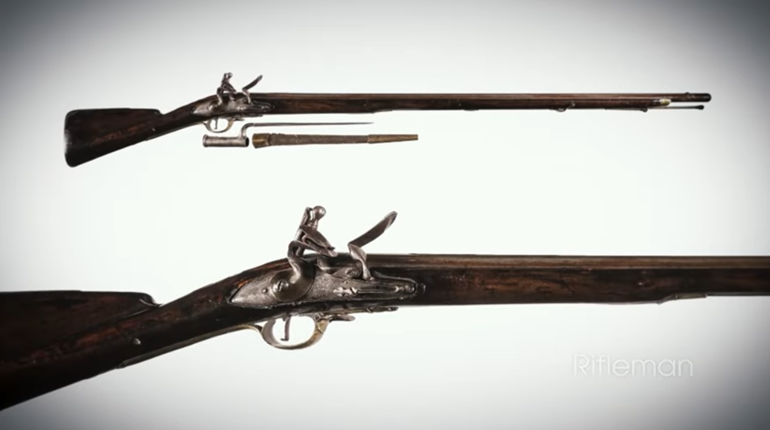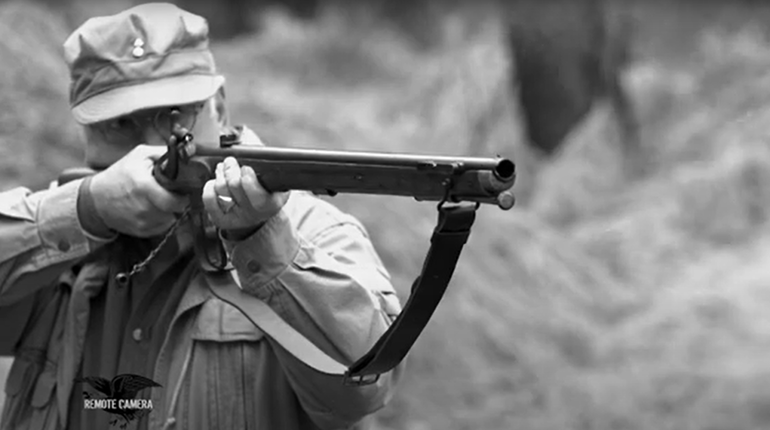
Few frontiersmen of the late 18th Century were as adept as the Indians at hunting, tracking and wilderness warfare, but one white man surpassed even the Native Americans at those skills, becoming a legend in the process: Simon Kenton. He was a contemporary of Daniel Boone and just as well-known and respected in the Ohio River Valley.
Standing 6 feet, 5 inches tall and weighing 250 pounds, he was a giant of a man for his time. And he would need every bit of his size, strength and steel constitution to survive the greatest ordeal of his life. In the early fall of 1778, he was captured by Shawnee Indians, repeatedly tortured and sentenced to death by burning at the stake.
It began when Kenton, on a spying mission into Indian country north of the Ohio River, was surrounded and captured by a Shawnee named Bo-nah and four other warriors. Accused of killing Indians and stealing horses, this mighty enemy of the Shawnee was too great a catch to be killed outright. Instead, he was marched to Chillicothe, a principal town of the Shawnees, but not before Bo-nah and the others had a little fun with Kenton first.
They stripped him naked, then mounted him facing backwards on a wild horse. His hands were tied behind his back, and his ankles tied together beneath the belly of the horse. He then had a leather loop slipped over his head and around his neck, the end of which was tied around the horse’s neck. The horse was then swatted smartly on the rump and as expected exploded in violent bucking and spinning, trying to dislodge its rider.
The horse smashed Kenton against trees, dragged him under low-hanging branches and bounded through brush and briers, but the frontiersman hung on by locking his legs around the horse and grasping a little of the horse’s mane with his hands. After a few minutes—what likely seemed like hours to Kenton—the spent animal stood spraddle-legged, head low, out of breath with sides heaving. But Kenton was still aboard and still alive, however much the worse for wear. Skin had been peeled from his legs, back, neck, shoulders and head, and in addition he had a hundred or more puncture wounds and deep gouges seeping blood.
And that was just the beginning of Simon Kenton’s miseries during the weeks and months to come.
Upon arriving in Chillicothe several days later, Kenton was forced to run a gauntlet. The large Indian town was inhabited by several thousand Shawnees, and everyone turned out to participate in humbling this greatest of enemies. The two parallel gauntlet lines stretched for a quarter mile, and Kenton was again stripped and told that he must run between the lines and reach the council house (mis-kah-mi-qui in Shawnee) at the line’s end. If he stopped or fell he would be required to start over.
Looking at the two lines of screaming Indians, Kenton knew that few men survived a gauntlet run, especially one as long as this. But there was no time to think about that now. A drum began beating and Bo-nah struck the first blow, a strike with a stout stick across Kenton’s upper back so fierce that he thought one of his shoulder blades may have broken. Nevertheless, he sprinted down the gauntlet, pummeled by men, women and children wielding switches, sticks or clubs, 4 to 6 feet long.
Kenton nearly made it to the safety of the council house when he was felled by a series of violent blows to the head. Dragged back to the starting line, he was given only a few minutes to rest before beginning again. The second time he didn’t make it nearly as far before being knocked unconscious, the Indians continuing to beat his defenseless body long after he was insensible.
Simon Kenton was forced to run a total of nine gauntlets during his captivity, one at each of the Indian villages he and his captors passed on their way to Upper Sandusky where he would be executed. He had been sentenced to such a fate by Black Fish, principal chief of the Shawnee nation. As “cut-ta-ho-tha,” a condemned man, Kenton had his face, arms and upper body painted black, signifying death. Burning at the stake, a horrible, lingering death, was reserved for the Shawnees’ greatest enemies, and Kenton topped that list.
Knowing his future, Kenton determined to risk escape during his next gauntlet run at a small village known as Moluntha’s Town. As soon as he started down the gauntlet line, he made an abrupt 90-degree turn and sprinted toward a nearby woods. As he hoped might happen, the Indian men, women and children fell over each other trying to catch him. This gave Kenton the critical few seconds he needed to reach the woods ahead of the young braves and run for his life.
His lungs nearly bursting, he eventually outdistanced all his pursuers, but luck was not ultimately on his side. Within a few minutes Kenton ran into a small party of Shawnees mounted on horses who were en route to the village and didn’t even know a gauntlet run was in progress. The party was led by none other than the famous Shawnee war chief Blue Jacket.
As Kenton attempted to sprint away, Blue Jacket rode up beside him and struck him in the head with his tomahawk. Fortunately, Blue Jacket used the pipe end of the tomahawk and not the blade, which likely would have killed Kenton. But the injury was still serious; the blow punched a dime-sized hole a quarter-inch deep into Kenton’s skull. He didn’t regain consciousness until two days later.
Yet even more nightmare remained. On the trip to Upper Sandusky, Bo-nah became enraged with Kenton over a small, unintended offense and broke the frontiersman’s left arm with a blow from his stone-headed war club. A few days later, Kenton’s right collar bone was broken by an old Indian man swinging an axe who was distraught over the loss of his son at the hands of white soldiers.
But miraculously, upon reaching Upper Sandusky, Kenton’s luck suddenly and mercifully changed. On the morning he was to be executed, a pelting rainstorm began at dawn, soaking the large piles of wood surrounding the stake to which Kenton would have been tied. His death sentence, delayed that one additional day, provided the needed 24 hours of extra time for British captain Peter Drouilliard to arrive from Fort Detroit.
Drouilliard was highly respected by the Indians, as the British were allied with the Ohio country tribes in fighting the Americans. In council, Drouilliard convinced the Shawnees that Kenton was worth more alive than dead, and that he wanted to take him back to Fort Detroit for questioning about the strength of American armies. The Shawnees reluctantly agreed, but only with the assurance that Kenton would be returned to them for execution after the questioning.
Captain Drouilliard agreed to the arrangement, but had no intention of returning Kenton. It seems he had been contacted by two of Kenton’s friends, who had asked him to intervene with the Indians on Kenton’s behalf. The two friends were frontier renegade Simon Girty and the Mingo Indian chief Logan, both of whom greatly admired Kenton.
Simon Kenton was taken to Fort Detroit across Lake Erie by canoe, his bones set and his many other injuries attended to by the fort physician. After several months' recuperation, Kenton was nearly back to full health and began planning his escape from the British.
He and Drouilliard developed a friendship during the long winter and, surprisingly, Drouilliard helped Kenton escape. Also assisting Kenton was John Edgar, a white trader living at the fort, and his wife Rachel. The couple and Drouilliard provided Kenton with a rifle, food, clothing and other supplies. For their efforts, the trio would later be arrested and charged with treason.
But Simon Kenton was long gone by then. In early June 1779—and not yet 24 years old—he slipped out of Fort Detroit by night. He had been advised not to travel directly south, as other captives had tried that route and all had been caught by the Indians and killed. Instead, Kenton headed northwest for a few miles, then directly west for three days before turning south. That took him out of heavily-populated Indian country, and by staying off trails, traveling only at night, and leaving no sign he eventually arrived at the Ohio River. Pushing a log into the stream and hanging on, he kicked his way across and arrived safely back in Kentucky about a month after leaving Detroit.
Simon Kenton—the man the Shawnees called the Great White Wolf—survived many more scrapes with Native Americans during his long life, and died in poverty at age 81 on his small farm near Zanesfield, Ohio, in 1836. If you’d like to read more about the life and times of Simon Kenton, the book The Frontiersmen by Allan Eckert is highly recommended.







































